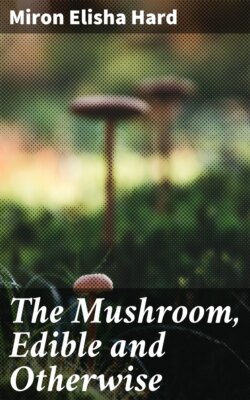Читать книгу The Mushroom, Edible and Otherwise - Miron Elisha Hard - Страница 21
На сайте Литреса книга снята с продажи.
Amanita muscaria. Linn.
ОглавлениеTable of Contents
The Fly Amanita. Poisonous.
Figure 13.—Amanita muscaria.—Linn. Cap reddish or orange, showing scales on the cap and at base of stem.
Muscaria, from musca, a fly. The fly Amanita is a very conspicuous and handsome plant. It is so called because infusions of it are used to kill flies. I have frequently seen dead flies on the fully developed caps, where they had sipped of the dew upon the cap, and, like the Lotos-eaters of old, had forgotten to move away. It is a very abundant plant in the woods of Columbiana county, this state. It is also found frequently in many localities about Chillicothe. It is often a very handsome and attractive plant, because of the bright colors of the cap in contrast with the white stem and gills, as well as the white scales on the surface of the cap. These scales seem to behave somewhat differently from those of other species of Amanita. Instead of shrivelling, curling, and falling off they are inclined to adhere firmly to the smooth skin of the pileus, turning brownish, and in the maturely expanded plant appear like scattered drops of mud which have dried upon the pileus, as you will observe in Figure 13.
The pileus is three to five inches broad, globose at first, then dumb-bell in shape, convex, then expanded, nearly flat in age; margin in matured plants slightly striate; the surface of the cap is covered with white floccose scales, fragments of the volva, these scales being easily removed so that old plants are frequently comparatively smooth. The color of the young plant is normally red, then orange to pale yellow; late in the season, or in old plants, it fades to almost white. The flesh is white, sometimes stained yellow close to the cuticle.
The gills are pure white, very symmetrical, various in length, the shorter ones terminating under the cap very abruptly, crowded, free, but reaching the stem, decurrent in the form of lines somewhat broader in front, sometimes a slight tinge of yellow will be observed in the gills.
The stem is white, often yellowish with age, pithy and often hollow, becoming rough and shaggy, finally scaly, the scales below appearing to merge into the form of an obscure cup, the stem four to six inches long.
The veil covers the gills of the young plant and later is seen as a collar-like ring on the stem, soft, lax, deflexed, in old specimens it is often destroyed. The spores are white and broadly elliptical.
The history of this plant is as interesting as a novel. Its deadly properties were known to the Greeks and Romans. The pages of history record its undoing and its accessory to crime. Pliny says, alluding to this species, "very conveniently adapted for poisoning." This was undoubtedly the species that Agrippina, the mother of Nero, used to poison her husband, the Emperor Claudius; and the same that Nero used in that famous banquet when all his guests, his tribunes and centurions, and Agrippina herself, fell victims to its poisonous properties.
However, it is said this mushroom is habitually eaten by certain people as an intoxicant; indeed, it is used in Kamchatka and Asiatic Russia, generally, where the Amanita drunkard takes the place of the opium fiend and the alcohol bibber in other countries. By reading Colonel George Kennan in his "Tent-life in Siberia," and Cooke's "Seven Sisters of Sleep," you will find a full description of the toxic employment of this fungus which will far surpass any possible imagination.
It caused the death of the Czar Alexis of Russia; also Count de Vecchi, with a number of his friends, in Washington in 1896. He was in search of the Orange Amanita and found this, and the consequences were serious.
In size, shape, and color of the cap there is similarity, but in other respects the two are very different. They may be contrasted as follows:
Orange Amanita, edible.—Cap smooth, gills yellow, stem yellow, wrapper persistent, membranaceous, white.
Fly Amanita, poisonous.—Cap warty, gills white, stem white, or slightly yellowish, wrapper soon breaking into fragments or scales, white or sometimes yellowish brown.
Found along roadsides, wood margins, and in thin woods. It prefers poor soil, and is more abundant where poplar and hemlock grow. From June to frost.
Figure 14.—Amanita muscaria.—Linn. One-half natural size, showing development of the plant.
